Introduction
The common base amplifier is probably the most confusing and difficult of the three classical configurations to understand, especially for beginners. But with proper analysis techniques, it can be tamed.

When first introduced to BJTs, we are taught “if you put more current in the base, much more current will flow through the transistor”. So it’s very confusing for beginners when they see an amplifier where the input isn’t applied to the base. Indeed, in a common base amplifier, the input is actually applied at the emitter, will the output is sampled at the collector. Let’s see exactly how this circuit works.
Voltage Gain
First, we need to draw out the small signal equivalent circuit:
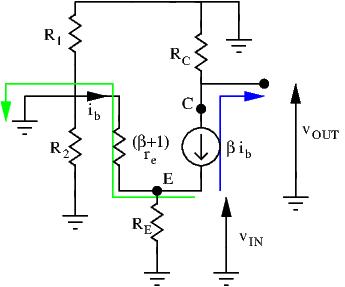
A KVL loop from ground to ground gives us:
![]()
With ![]() being the voltage of the current source. Rearranging terms and replacing
being the voltage of the current source. Rearranging terms and replacing ![]() with
with ![]() we have
we have ![]()
Our goal is to express ![]() as a function of
as a function of ![]() . Lets see what we can do. Following the blue line:
. Lets see what we can do. Following the blue line:
![]()
Substituting v_{CE} with the expression found above, we obtain:
![]()
(1) ![]()
A second KVL loop (green line) gives us the following:
![]()
Isolating i_b we get:
![]()
Substituting i_b in equation (1) gives us:
![]()
Since ![]() , we can safely make the approximation that
, we can safely make the approximation that ![]() , and we obtain the following equation:
, and we obtain the following equation:
(2) ![]()
We have ![]() . Since
. Since ![]() , the CB amplifier has a high voltage gain.
, the CB amplifier has a high voltage gain.
Current Gain
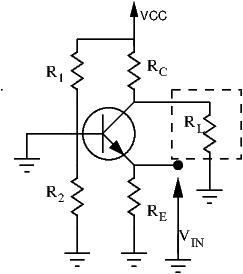
We can’t use the same shortcut we used on the other two configurations. In the other configurations, input current was base current, and output current was either collector or emitter current. Thus, current gain was easily ![]() . Here, input is at the emitter, and output is at the collector.
. Here, input is at the emitter, and output is at the collector. ![]() forces a current into
forces a current into ![]() . This same current is found coursing through the transistor (
. This same current is found coursing through the transistor (![]() ). Academically, to find the current gain of a circuit, we short out the load and calculate the short circuit current, as shown on the above diagram. Shorting the load makes the AC signal ignore
). Academically, to find the current gain of a circuit, we short out the load and calculate the short circuit current, as shown on the above diagram. Shorting the load makes the AC signal ignore ![]() . All the current flows through the short. Thus, output current is the same is input current. Current gain is unity, or no current gain.
. All the current flows through the short. Thus, output current is the same is input current. Current gain is unity, or no current gain.
Input Resistance
We find the input resistance the usual way: by applying a test signal at the input and determining the test current.
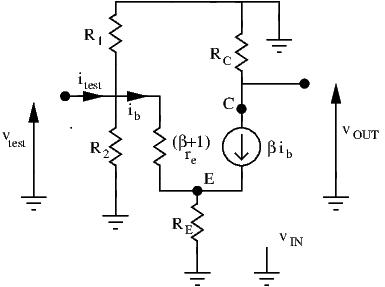
At the emitter node, test current flow to three branches: from the current source, to ![]() and to base. Thus, we have
and to base. Thus, we have
![]()
Using Ohm’s law ![]() is easy to find:
is easy to find:
![]()
Substituting for ![]() in i_{TEST}, and applying Ohm’s law for
in i_{TEST}, and applying Ohm’s law for ![]() and
and ![]() gives:
gives:
![]()
![]()
We recognize a parallel resistance ![]() . Rearranging terms we obtain:
. Rearranging terms we obtain:
![]()
The input resistance is thus ![]() . When evaluating parallel resistances, take note of the lowest value. Here, it’s
. When evaluating parallel resistances, take note of the lowest value. Here, it’s ![]() (tens of ohms generally). An equivalent parallel resistance has a lower value than any of its contributing resistors, so
(tens of ohms generally). An equivalent parallel resistance has a lower value than any of its contributing resistors, so ![]() .
. ![]() is thus low.
is thus low.
Output Resistance
To simplify the process of determining the output resistance, let’s find the equivalent Thevenin circuit of our amplifier.
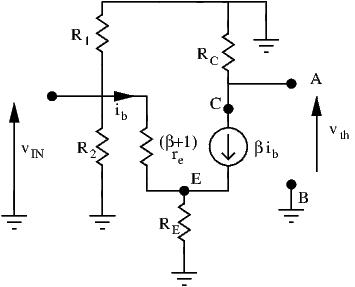
- The open circuit voltage between A and B was already calculated previously when we derived the voltage gain. Here,
 . This is our Thevenin voltage.
. This is our Thevenin voltage. - Since we have both a dependent source
 and an independent source
and an independent source  , we short AB to find the short circuit current
, we short AB to find the short circuit current  :
:
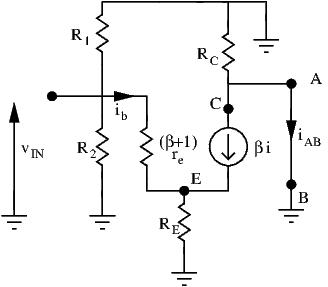
Since the short bypasses , the short circuit current is simply:
, the short circuit current is simply: 
A KVL loop from emitter to ground gives us the relationship between and
and  :
:
![Rendered by QuickLaTeX.com \[ V_{IN} -(\beta +1) \times r_e \times i_b = 0 \]](http://modernhamguy.com/wp-content/ql-cache/quicklatex.com-66f1628cf3e5a0ce53bbc3a586abc6dd_l3.png)
![Rendered by QuickLaTeX.com \[ i_b = \frac{v_{IN}}{(\beta +1) \times r_e} \]](http://modernhamguy.com/wp-content/ql-cache/quicklatex.com-09f86f8eb2a6487a5425a57a170ab83b_l3.png)
We can now find the final expression of
 :
:![Rendered by QuickLaTeX.com \[ i_{AB} = \beta \times \frac{v_{IN}}{(\beta +1) \times r_e} = \frac{v_{IN}}{r_e} \]](http://modernhamguy.com/wp-content/ql-cache/quicklatex.com-2403744c79ffd2a93d228a3761c6a624_l3.png)
- We can now derive
 :
:
![Rendered by QuickLaTeX.com \[ R_{th} = \frac{v_{AB}}{i_{AB}} = \frac{R_C}{r_e} \times v_{IN} \times \frac{r_e}{v_{IN}} = R_C \]](http://modernhamguy.com/wp-content/ql-cache/quicklatex.com-6a51c7e2e44d596fd31d7fe8ea5e8c97_l3.png)
- The CB amplifier can be simplified as :
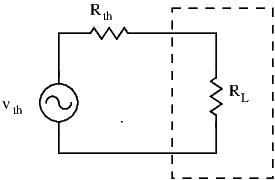
Quite trivially, we can now see that the output resistance ![]() of the amplifier is simply
of the amplifier is simply ![]() . This value can be moderately high.
. This value can be moderately high.
Use Cases
Why would we want to use the CB amplifier? Its low input resistance comes in handy if we need to amplify signals that come from low resistance sources. It’s especially useful in audio circuits.
It also has its use in RF circuits. To understand why we’ll need a little more theory under our belt. We’ll explain why its so useful in the next chapter on the Miller effet.
Design
Many people forget that in a CB configuration, the base must still be biased. Indeed, a stable voltage reference at the base must be applied, commonly through a voltage divider circuit.
Even more people are confused as to how this circuit even works, even after working through the equations. This circuit seems like it goes against the common logic of BJT: where input current at the base is amplified through C-E junction. But here, the base is “common” and no input signal is fed through it. So how can this amplifier work?
Well, with the voltage divider circuit, ![]() is constant. Yet
is constant. Yet ![]() changes with the input signal
changes with the input signal ![]() . Thus,
. Thus, ![]() is changing. There is a formula linking
is changing. There is a formula linking ![]() and
and ![]() :
:
![]()
This equation demonstrates the physics behind the transistor’s operation, but is seldom used for circuit design. Just know that chaning ![]() causes
causes ![]() to change with it. This is how the CB amplifier works. As
to change with it. This is how the CB amplifier works. As ![]() goes lower,
goes lower, ![]() increases and more current is sunk through the BE junction, lowering
increases and more current is sunk through the BE junction, lowering ![]() .
.
Conclusion
Let’s recap the fundamental characteristics of the Common Base amplifier:

 \approx 1
\approx 1 R_{OUT} = R_C$
R_{OUT} = R_C$